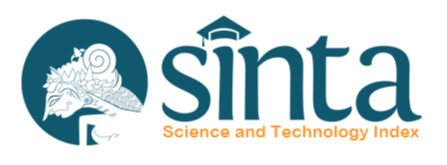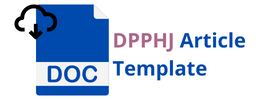The Impact of Work Method on Musculoskeletal Disorders Complaints in Pharmacy Unit
DOI:
https://doi.org/10.12928/dpphj.v14i2.2478Keywords:
MSDs, ergonomics, pharmaceuticals, methods, workAbstract
Background: Musculoskeletal disorders (MSDs) are complaints on parts of skeletal muscle which is perceived by someone ranging from mild to severe. These complaints often occur in the manual process, heavy workload, and work environment interactions that may lead to a non-ergonomic work posture. This study aims to analyze the impact of the work method to MSDs complaints at the pharmacy unit of The University of Sumatera Utara Hospital. Method: This study is an observational survey using a cross-sectional design. The population was all workers in the pharmacy unit of the University of Sumatera Utara Hospital numbered 27 people. Samples were taken from the total population. Data were collected using camera media and direct observation of the work process that took place in the pharmacy unit of USU Hospital. Musculoskeletal complaints were obtained by mapping the pain using Nordic Body Map (NBM). The data obtained were analyzed using a simple logistic regression test to see the impact of the working methods of the pharmacy unit workers on their complaints of musculoskeletal disorders. Results: There was a significant association between work methods in the Pharmacy unit and the MSDs complaints with p-value = 0,001. This was supported by the mean of the work patterns in the pharmacy unit which have a heavy workload and the interaction with the layout according to anthropometry. There was a significant association between the work method causing musculoskeletal complaints when the drug compounding process (p = 0.000). It was evidenced from the result of NBM questionnaire that the three most prevalent complaints of MSDs were pain around the neck, back, and right shoulder. Conclusion: It can be concluded that the static working methods with a heavy workload must be accompanied by a relaxation to avoid burn out and fatigue.
References
2. Humantech Inc. Applied Ergonomics Training Manual. Berkeley Vale Australia: Protector and Gamble Inc; 2002.
3. Wang J, Cui Y, He L, Xu X, Yuan Z, Jin X, et al. Work-related musculoskeletal disorders and risk factors among Chinese medical worker of obstetrics and gynecology. Int J Environ Res Public Health. 2017;14(6):1–13.
4. Stock S, Baril R, Dion-Hubert C, Lapointe C, Paquette S, Sauvage J, et al. Work-related Musculoskeletal Disorders Guide and Tools for Modified Work. Montréal: santé publique; 2005. 1–63 p.
5. Hossain MD, Aftab A, Al Imam MH, Mahmud I, Chowdhury IA, Kabir RI, et al. Prevalence of work related musculoskeletal disorders (WMSDs) and ergonomic risk assessment among readymade garment workers of Bangladesh: A cross sectional study. PLoS One. 2018;13(7):1–18.
6. Luan HD, Hai NT, Xanh PT, Giang HT, Van Thuc P, Hong NM, et al. Musculoskeletal Disorders: Prevalence and Associated Factors among District Hospital Nurses in Haiphong, Vietnam. Biomed Res Int. 2018;2018:1–9.
7. Kim SS, Okechukwu CA, Dennerlein JT, Boden LI, Hopcia K, Hashimoto DM, et al. Association between perceived inadequate workering and musculoskeletal pain among hospital patient care workers. Int Arch Occup Environ Health. 2014;87(3):323–30.
8. Kinge JM, Knudsen AK, Skirbekk V, Vollset SE. Musculoskeletal disorders in Norway: Prevalence of chronicity and use of primary and specialist health care services. BMC Musculoskelet Disord. 2015;16(1):1–9.
9. Ribeiro T, Serranheira F, Loureiro H. Work Related Musculoskeletal Disorders in Primary Health Care Nurses. Appl Nurs Res. 2017;33:72–7.
10. Blanchette MA, Rivard M, Dionne CE, Hogg-Johnson S, Steenstra I. Workers’ characteristics associated with the type of healthcare provider first seen for occupational back pain. BMC Musculoskelet Disord. 2016;17(1):1–15.
11. Munabi IG, Buwembo W, Kitara DL, Ochieng J, Mwaka ES. Musculoskeletal disorder risk factors among nursing workers in low resource settings: A cross-sectional study in Uganda. BMC Nurs. 2014;13(1):1–8.
12. World Health Organization. WHO Global Plan of Action on Workers’ Health (2008-2017): Baseline for Implementation. World Health Organization. 2013.
13. Tubagus AP, Doda DVD, Wungouw HIS. Hubungan Tingkat Risiko Musculoskeletal Disorders (MSDs) Mengguna-kan Rapid Entire Body Assessment (REBA) dengan Keluhan MSDs pada Residen Ilmu Bedah. J Biomedik. 2018;10(3):168–73.
14. Labour Force Survey (LFS). LFS - Labour Force Survey - Self-reported work-related ill health and workplace injuries: Index of LFS tables [Internet]. United Kingdom; 2019.
15. Health and Safety Executive. Work related musculoskeletal disorder statistics (WRMSDs) in Great Britain, 2019. Health and Safety Executive. United Kingdom: Health and Safety Executive; 2019.
16. OSHA. Caring for our caregivers: Facts about Hospital Worker Safety. 2013.
17. Tribble AG, Summers P, Chen H, Quandt SA, Arcury TA. Musculoskeletal Pain, Depression, and Stress among Latino Manual Laborers in North Carolina. Arch Environ Occup Heal. 2016;71(6):309–16.
18. OSHA. Ergonomics: Guidelines for Nursing Homes: Ergonomics for the Prevention of Musculoskeletal Disorders. Occupational Safety and Health Administration. Washington, DC, USA: OSHA; 2009.
19. Labbafinejad Y, Imanizade Z, Danesh H. Ergonomic Risk Factors and Their Association with Lower Back and Neck Pain among Pharmaceutical Workers in Iran. Work Heal Saf. 2016;64(12):586–95.
20. Syahidah HN, Musfiroh I. Review: Aspek Keamanan dan Keselamatan Kerja dalam Produksi Sediaan Farmasi. Farmaka. 2018;16(1):13–20.
21. OSHA. Hospital e-Tools: Pharmacy Ergonomics [Internet]. Occupational Safety and Health Administration. [cited 2020 May 2]. Available from: https://www.osha.gov/SLTC/etools/hospital/pharmacy/pharmacy.html#Ergonomics]
22. Nurfitria RS, Sutrisno E, Ramadhania S. The potency of musculoskeletal disorders ergonomic risks of pharmacy worker at a hospital pharmacy installation in Bandung. Asian J Pharm Clin Res. 2018;11(13):181–6.
23. Istighfaniar K, Mulyono M. Evaluasi Postur Kerja Dan Keluhan Muskoloskeletal Pada Pekerja Instalasi Farmasi. Indones J Occup Saf Heal. 2017;5(1):81.
24. Baadjou VAE, Roussel NA, Verbunt JAMCF, Smeets RJEM, de Bie RA. Systematic review: Risk factors for musculoskeletal disorders in musicians. Occup Med (Chic Ill). 2016;66(8):614–22.
25. Madadizadeh F, Vali L, Rafiei S, Akbarnejad Z. Risk factors associated with musculoskeletal disorders of the neck and shoulder in the personnel of Kerman University of Medical Sciences. Electron physician. 2017;9(5):4341–8.
26. Carrillo-Castrillo JA, Pérez-Mira V, Del Carmen Pardo-Ferreira M, Rubio-Romero JC. Analysis of required investigations of work-related musculoskeletal disorders in Spain. Int J Environ Res Public Health. 2019;16(10):1–14.
27. Tsekoura M, Koufogianni A, Billis E, Elias. T. Work - Related Musculoskeletal Disorders Among Female And Male Nursing Personnel In Greece. World J Res Rev. 2017;3(1):8–15.
28. Akodu AK, Ashalejo ZO. Work-related musculoskeletal disorders and work ability among hospital nurses. J Taibah Univ Med Sci. 2019;14(3):252–61.
29. Chanchai W, Songkham W, Ketsomporn P, Sappakitchanchai P, Siriwong W, Robson MG. The impact of an ergonomics intervention on psychosocial factors and musculoskeletal symptoms among Thai hospital orderlies. Int J Environ Res Public Health. 2016;13(5):1–10.
30. Bernal D, Campos-Serna J, Tobias A, Vargas-Prada S, Benavides FG, Serra C. Work-related psychosocial risk factors and musculoskeletal disorders in hospital nurses and nursing aides: A systematic review and meta-analysis. Int J Nurs Stud. 2015;52(2):635–48.
31. Harris-Adamson C, Bao SS, Evanoff B. Musculoskeletal disorders. In: Occupational and Environmental Health. Oxford, United Kingdom: Oxford University Press; 2017. p. 433–60.
32. Serranheira F, Sousa-Uva M, Sousa-Uva A. Hospital nurses tasks and work-related musculoskeletal disorders symptoms: A detailed analysis. Work. 2015;51(3):401–9.
33. Alhasan M, Abdelrahman M, Alewaidat H, Almhdawi K, Nazzal M. Work-related stress, musculoskeletal disorder complaints, and stress symptoms among radiographers in the northern part of Jordan. J Med Imaging Radiat Sci. 2014;45(3):291–8.
34. Carneiro P, Martins J, Torres M. Musculoskeletal disorder risk assessment in home care nurses. Work. 2015;51(4):657–65.
35. Nuryaningtyas B., Martiana T. Analisis Tingkat Risiko Muskuloskeletal Disorders (MSDs) Dengan The Rapid Upper LIMBS Assessment (RULA) Dan Karakteristik Individu Terhadap Keluhan MSDs. Indones J Occup Saf Heal. 2014;3(2):160–9.
36. Mayasari D, Saftarina F. Ergonomi Sebagai Upaya Pencegahan Musculoskletal Disorders. J Kedokt Univ Lampung. 2016;1(2):369–79.
37. Fausiyah K. Hubungan Karakteristik Individu dan Iklmi Kejra dengan Keluhan MSDs pada Pekerja Perakitan Mini Bus di PT. Mekar Armada Jaya Magelang. Indones J Occup Saf Heal. 2017;6(1):48.
38. Wuriani, Rosa ME, Afandi M. Pengaruh Perbaikan Postur Kerja terhadap Nyeri Muskuloskeletal pada Perawat di Klinik Kitamura Pontianak The Influence of Work Posture Improvement to Musculoskeletal Pain Kitamura Clinic Pontianak Nurses. Mutiara Med. 2017;17(1):22–8.
39. Chaléat-Valayer E, Denis A, Abelin-Genevois K, Zelmar A, Siani-Trebern F, Touzet S, et al. Long-term effectiveness of an educational and physical intervention for preventing low-back pain recurrence: A randomized controlled trial. Scand J Work Environ Heal. 2016;42(6):510–9.
40. Nourollahi M, Afshari D, Dianat I. Awkward trunk postures and their relationship with low back pain in hospital nurses. Work. 2018;59(3):317–23.
41. MacDonald V, Keir PJ. Assessment of Musculoskeletal Disorder Risk with Hand and Syringe use in Chemotherapy Nurses and Pharmacy Assistants. IISE Trans Occup Ergon Hum Factors. 2018;6(3–4):128–42.
42. Chiasson M eve, Imbeau D, Major J, Aubry K, Delisle A. Influence of musculoskeletal pain on workers’ ergonomic risk-factor assessments. Appl Ergon. 2015;49:1–7.
43. Rahman M, Chowdhury A, Zaman MS, Sultana N, Amin MB, Hossain MM. Work-related musculoskeletal disorders among health care workers. Updat Dent Coll J. 2017;7(1):4–9.
44. Hagiwara Y, Yabe Y, Yamada H, Watanabe T, Kanazawa K, Koide M, et al. Effects of A Wearable Type Lumbosacral Support for Low Back Pain among Hospital Workers: A Randomized Controlled Trial. J Occup Health. 2017;59(2):201–9.
45. Jakobsen MD, Sundstrup E, Brandt M, Jay K, Aagaard P, Andersen LL. Effect of workplace-versus home-based physical exercise on musculoskeletal pain among healthcare workers: A cluster randomized controlled trial. Scand J Work Environ Heal. 2015;41(2):153–63.
Downloads
Published
Issue
Section
License
Authors transfer the copyright and grant the Disease Prevention and Public Health Journal right of first publication with the work simultaneously licensed under a Creative Commons Attribution License (CC BY-SA 4.0) that allows others to share (copy and redistribute the material in any medium or format) and adapt (remix, transform, and build upon the material) the work for any purpose, even commercially with an acknowledgement of the work's authorship and initial publication in Disease Prevention and Public Health Journal. Authors are able to enter into separate, additional contractual arrangements for the non-exclusive distribution of the journal's published version of the work (e.g., post it to an institutional repository or publish it in a book), with an acknowledgement of its initial publication in Disease Prevention and Public Health Journal. Authors are permitted and encouraged to post their work online (e.g., in institutional repositories or on their website) prior to and during the submission process, as it can lead to productive exchanges, as well as earlier and greater citation of published work (See The Effect of Open Access).

This work is licensed under a Creative Commons Attribution-ShareAlike 4.0 International License.







